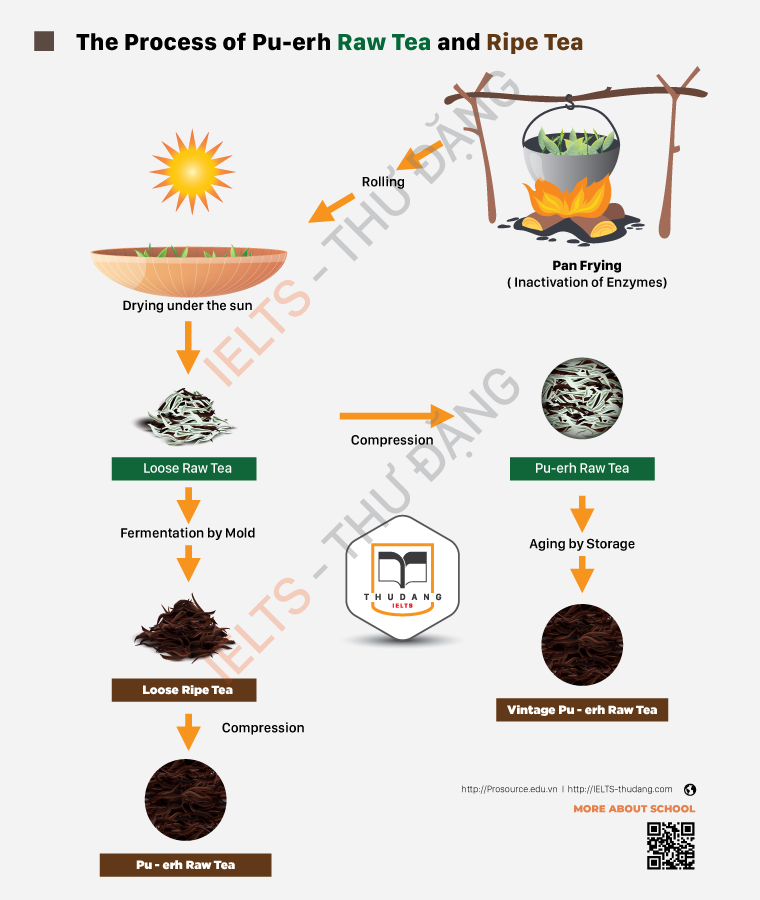IELTS THƯ ĐẶNG- TRUNG TÂM LUYỆN THI IELTS UY TÍN, CHẤT LƯỢNG TẠI HÀ NỘI
Tham khảo các bài liên quan:
>>> Kinh nghiệm luyện thi IELTS
>>> Hướng dẫn làm bài thi IELTS
IELTS Task 1 Process: Tea
The Process of Pu-erh Raw Tea and Ripe Tea
The Process of Pu-erh Raw Tea and Ripe Tea IELTS Writing Task 1 sample Answer is given below. The candidates are required to present a tentative answer for the same. The Process of Pu-erh Raw Tea and Ripe Tea IELTS Writing Task 1 requires candidates to write a summary or overview based on a diagram, a table, a line graph, or a bar graph in at least 150 words. IELTS academic writing task 1 is a writing task for 150 words. Candidates are given 20 minutes and are required to write a summary for IELTS Academic writing task 1. IELTS writing score is marked based on band scores. The band scores range from 0 to 9. Meanwhile, candidates might consider practicing from IELTS writing practice papers to help excel your writing skills.
Topic: The Process of Pu-erh Raw Tea and Ripe Tea. Summarise the information by selecting and reporting the main features, and make comparisons where relevant.

Band 7 Answer
Pu-erh is a fantastic Chinese tea to try out because it has a highly distinctive shape, scent, flavour, and look. This tea was produced in Yunnan, where it was first grown. It's crucial to remember that this tea can be divided into two groups: fermented tea and non-fermented tea. The production of two different kinds of tea Pu-erh raw tea and Pu-erh ripe tea is shown in the diagram. Although the first three stages of manufacturing for both teas are identical. It is clear that the later stages' techniques of production are different, which explains the differences between the two teas' flavours. To start, the tea leaves are first pan-fried to inactivate the enzymes after they have been selected. The tea is next rolled, and finally stretched out on a circular mat so that it can dry in the sun. The loose raw tea can now be transformed into either ripe tea or raw tea after being dried. This is the turning point in the process. To make Pu-erh ripe tea, the next step is to ferment the loose tea by allowing it to mould. After the loose, ripe tea has finished fermenting, it is compressed, at which point it is ready for sale. In the alternate method, loose tea is first crushed and then allowed to age through storage before being prepared for sale as vintage raw tea.
|
Band 7.5 Answer
Pu-erh has a very distinct shape, aroma, flavour, and appearance, making it a terrific Chinese tea to taste. Yunnan, where the tea was first cultivated, is where it was created. It's important to keep in mind that there are two types of this tea: fermented tea and non-fermented tea. The figure illustrates the production of two varieties of tea, known as pu-erh Raw Tea and Ripe Tea.
The first three stages of the production of both teas are similar. It is clear from the finished products that the production processes were different, which explains the variances in the two teas. The enzymes are first inactivated by pan-frying the tea. After that, roll the tea and put it out on a mat so that it can dry in the sun. The loose raw tea is prepared to be brewed into either ripe tea or raw tea for the following phase. The division in the process occurs here. Pu-erh mature tea is produced by fermenting loose tea that has been allowed to mould. After the fermenting process is complete, the ripe tea is compressed and made suitable for consumption. Regarding the other phase, the loose tea is compressed one more time before being stored to mature. And become pu-erh Raw Tea which is suitable for distribution as vintage Raw Tea.
|
Band 8 Answer Pu-erh is a fantastic Chinese tea to taste because of its distinctive shape, scent, flavour, and appearance. It was created in Yunnan, where tea was first grown. You should be aware that this tea comes in two varieties: fermented tea and non-fermented tea. The provided diagram demonstrates the production process for two varieties of Pu-erh tea, known as Raw and Ripe teas.
Overall, it is clear that this procedure is accomplished in five phases, albeit the first three are the same for both types of tea. The tea leaves are first fried in a skillet before being rolled in order to deactivate the enzymes. The fact that four planks of wood are used to fuel the pan is obvious. The rolled tea leaves are then kept in the sun for the remainder of the drying process. The loose Raw tea is then regarded as being in the last stage. In the following stage, loose Raw tea is crushed into Pu-erh Raw tea. While also being fermented by mould to produce loose Ripe tea. After the Pu-erh Raw tea is crushed, it is aged in storage before being made available for sale as Vintage Pu-erh Raw tea. The loose ripe tea is compressed to become Pu-erh ripe tea, which is ready for sale, at the end of the cycle after being fermented by mould.
|
IELTS - Thư Đặng Tổng hợp!
Ngoài ra các bạn có thể tham khảo thêm rất nhiều nguồn tài liệu khác ở các thư mục của Website:




.png)

.png)
